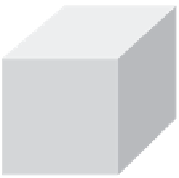Graphics Reference
In-Depth Information
Voxel in hierarchy
Solid angle
Δ
ω
x
i
(Sample point)
x
o
(Rendering point)
Figure 4.15
Criterion for descending the voxel hierarchy. The voxel itself is used if it fits into the cone
of a fixed solid angle, otherwise the algorithm descends into the subvoxels.
in Figure 4.15 is smaller than a particular threshold, the voxel is not considered
close to the evaluation point and the aggregate value is used. Otherwise, the test is
applied again at each subvoxel, and the process stops when the subvoxel is small
enough, or the finest level is reached. The voxels at the finest level contain a single
sample point.
Figure 4.16 contains images of a marble “Utah teapot” rendered with the
BSSRDF model. The left image was rendered using the basic sampling proce-
dure; the right image was rendered using the voxel hierarchy. Although the two
images are almost indistinguishable, the rendering times vary significantly: the
left image required 18 minutes to render; the right image, only seven seconds.
The fast translucency algorithm was developed in cooperation with PDI after
the publication of the original BSSRDF model, so the paper includes various en-
hancements that reflect the needs of movie production. For example, the dipole-
based multiple scattering model uses the parameters
σ
s
to specify the
σ
a
and
Figure 4.16
Comparison between a BSSRDF-based rendering (left) and a rendering using the “fast
translucency” algorithm (right). (From [Jensen and Buhler 02] c
2002 ACM, Inc. In-
cluded here by permission.)


























